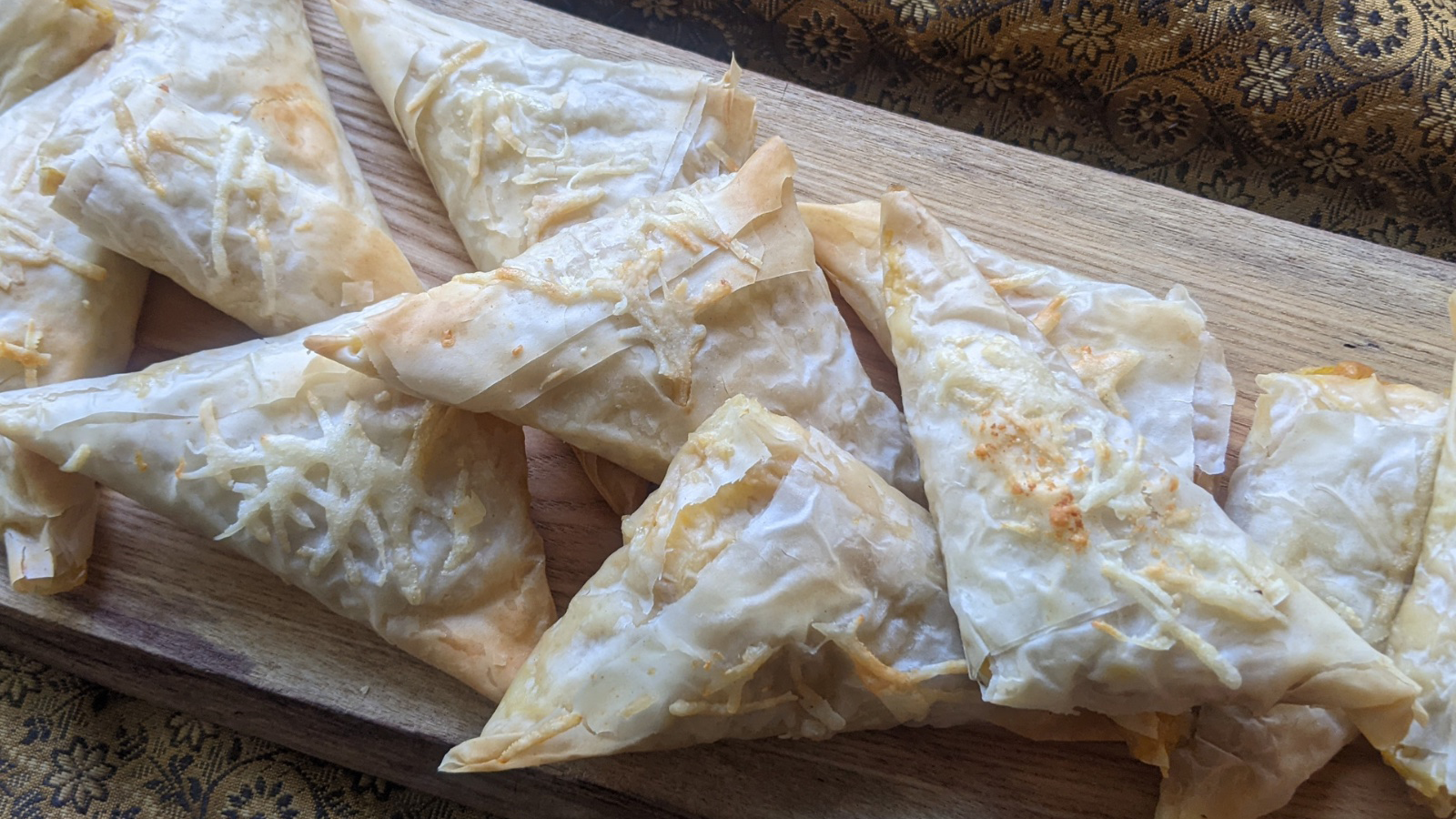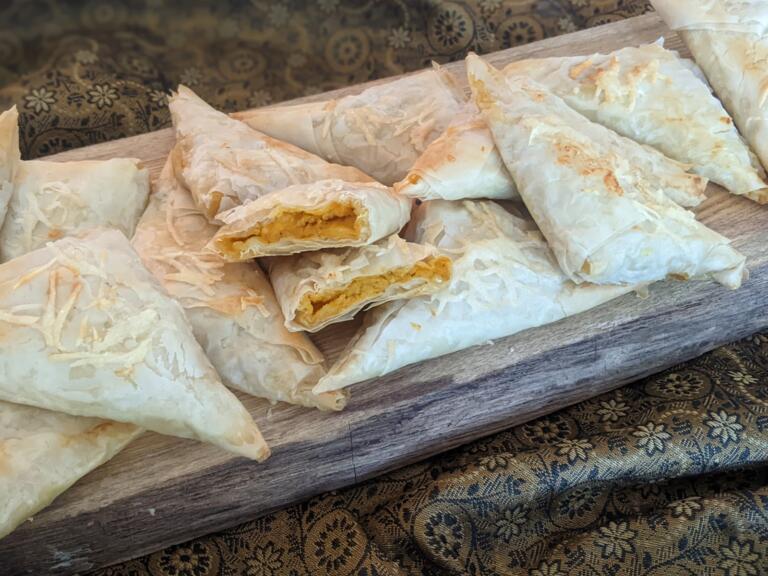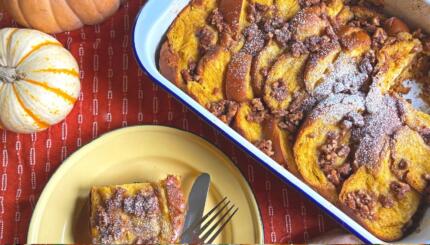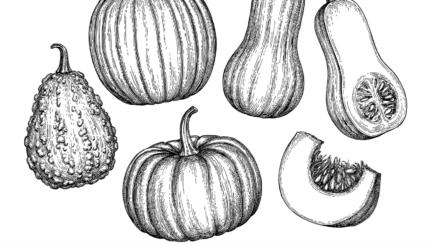I remember my first breakfast in a café during my first trip to Istanbul, nearly 30 years ago. Their most popular breakfast order was a big spinach-and-feta boureka and alongside, a huevo haminado, the long-cooked hard-boiled egg favored by Sephardim. In fact, that combination is eaten often, especially during Shabbat and holidays, for desayuno (breakfast in Ladino) as well as a light lunch or dinner by Jews of formerly Ottoman lands including Turkey and Greece (where they are called spanakopita).
Traditionally, two kinds of dough were used for bourekas, either filo to make triangles or more of a pastry dough, usually oil-based, folded into half-moons with edges twisted by skilled hands. Whichever kind of dough you used depended on where you lived and your family tradition. Today, both are used along with time-saving puff pastry as a modern alternative. This recipe uses filo because…well, that’s what my family used!
Bourekas today are sold in bakeries and roadside stands in Turkey, Israel and around the Middle East, often as “fast food” because, in addition to being delicious, they are perfect to prepare ahead, quick to heat up and easy to eat on the go. While spinach, potato, eggplant, meat and, on the sweet side, nuts are most popular, pumpkin bourekas are perfect for fall holidays. In fact, pumpkin (kalavasa in Ladino) is one of the symbolic foods included in the seven blessings at the Sephardic Rosh Hashanah Seder, sometimes represented by the savory pumpkin filling in a flaky boureka.
Sephardim have long favored pumpkin, ever since the 16th century when conquistadores brought it — along with the tomato, eggplant, corn and potato — back from the New World. In this country, pumpkin is most often associated with sweet foods like pies and cakes, but around the world, pumpkin is an important, inexpensive and very healthy ingredient in savory dishes as well with its long list of vitamins, minerals, anti-oxidants and other beneficial nutrients. This means pumpkin bourekas are delicious nourishment as part of a break fast meal, and even better since they can be prepared ahead and refrigerated or frozen before reheating, just before serving.
The Nosher celebrates the traditions and recipes that have brought Jews together for centuries. Donate today to keep The Nosher's stories and recipes accessible to all.
Pumpkin Bourekas
Bourekas de kalavasa or “pumpkin turnovers” are the perfect Sephardic dish for fall.
- Total Time: 45 minutes
- Yield: 2 dozen
Ingredients
- 1 15–ounce can pumpkin puree (about 1 ¾ cups)
- 1 large egg, beaten
- 1 cup crumbled feta cheese
- ½ cup grated Parmesan cheese with 2 tablespoons removed and set aside
- ½ tsp cinnamon
- ¼ tsp cardamom (optional)
- ½ tsp salt
- 1 package filo (phyllo) dough, defrosted according to package directions
- ½ cup olive oil or melted butter
Instructions
- Preheat oven to 350 degrees. Lightly grease 1 or 2 baking sheets or cover with parchment paper and lightly grease.
- Put all the ingredients except the 2 Tbsp of parmesan, the filo and olive oil or butter in a large mixing bowl and blend very well. Set aside.
- Open one package of filo and carefully unroll the dough. Using a sharp, large knife or a pizza cutter, cut the stacked sheets of filo the long way into 3 equal strips for larger bourekas or 4 strips for smaller.
- As you work, keep the dough soft and pliable until it’s ready to be used by covering with a very slightly damp cotton towel or plastic wrap or aluminum foil.
- Uncover one strip of stacked filo. Working quickly, lightly brush the top of a filo strip with oil or butter.
- Place about 1 teaspoon of filling on a bottom corner near you. At that corner, pull apart the top 2 strips of filo from the stack and fold it over so the corner with the filling crosses diagonally to the opposite edge, covering the filling. Then fold up triangle to square off the strip again. Repeat by folding a third time diagonally the opposite direction from the original fold, then square off again. Continue folding this way to the end of the strip. (Folding a boureka is exactly like folding a flag.)
- When folded to the end, brush the edge of the dough with oil or butter and wrap it around the triangle to close it. Don’t worry if the dough cracks or tears. Just use oil or butter to “glue” the dough back together.
- Place on the prepared baking sheet and brush the outside very lightly with oil or butter. Repeat until all the filling is used.
- Boureka triangles should be close, but not touching, on the baking sheet. When the sheet is full, sprinkle each boureka with a little of the 2 Tbsp of parmesan cheese that was set aside.
- Bake about 20 minutes until golden. Serve warm.
- Baked bourekas can be refrigerated or frozen, then reheated as needed. To reheat, place bourekas on a parchment-covered baking sheet in a preheated 350-degree oven until heated through, 10 minutes if defrosted or 20-25 minutes if frozen.
- Prep Time: 15 minutes
- Cook Time: 30 minutes
- Category: Appetizer
- Method: Baking
- Cuisine: Sephardic





Leave a Comment